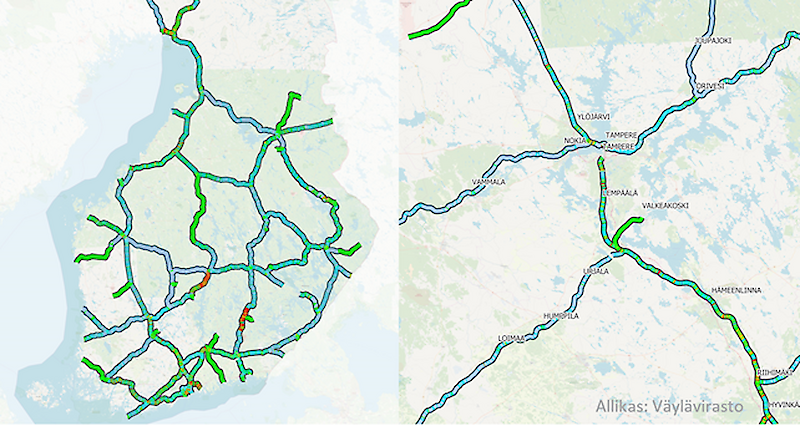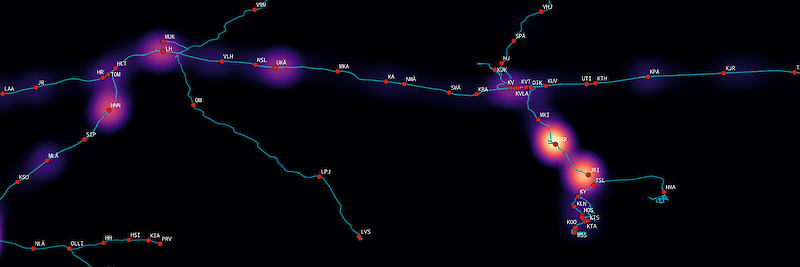- Employers
- Proxion Estonia OÜ

Railway consultancy, training and design services
Proxion at the railway infrastructure technological development map
Couldn't get to the computer in time to follow our presentation on "Proxion on the technological development map of rail infrastructure" at the Key to the Future seminar?
No problem!
We've made the presentation available for you to watch at your leisure. :)
More about Proxion Estonia OÜ
Founded in 2005, the Proxioni Group offers services in the fields of railway infrastructure planning, design, project implementation, training and digitalisation.
Proxion Estonia OÜ is the Finnish company's subsidiary in Estonia and we have started operations this year. In addition to our newly established office in Tallinn in the Science Park Tehnopol, Proxion has six offices in Finland.
We are committed to the development of the safety, usability and smooth operation of rail transport, and we aim to increase the efficiency of rail infrastructure through our activities.
We are well known in Finland as a provider of training services in the railway sector and we will soon be heading to the Estonian market with the same concept. We provide training for skilled personnel in the field of railway infrastructure track, contact network, telecommunications and security systems.
We will train railway experts who are up to date with the latest trends in the development of technologies for the safety of rail traffic. We support infrastructure managers in the preparation and implementation of major investment projects, and our clients include rail infrastructure managers, infrastructure construction companies and rail automation manufacturers throughout Europe.
Proxion video
A brief overview of what we do.
Take a look and you'll find out who we are.
Autonomous train
The advantage of road transport is flexibility and the ability to manoeuvre the load to its destination in tight conditions. On the other hand, road transport has the disadvantage of relatively low transport volumes per truck. The traditional method of moving large volumes of goods by lorry and in small stages requires high traffic density in industrial areas. High traffic density, however, increases the level of emissions into the environment and the likelihood of accidents. Increasingly stringent environmental and safety requirements are forcing us to consider alternatives to industrial logistics.
Proxion has launched an autonomous train project and involved several partners in the development, including the Finnish National Technical Research Institute. The aim of the Autonomous Train development project is to create an environmentally friendly, safe and economically competitive transport solution for short-distance logistics needs in industrial areas.
DUOLIFE
The Duolife project aims to develop and pilot a carbon-neutral logistics chain linking the surrounding areas to the city and complementing the city's transport network, using part of the existing rail infrastructure. Figuratively speaking, the tram will run on the tramway for a section and then again on the public railway. Environmentally friendly and convenient, modern transport solutions will enhance the vitality and attractiveness of the suburban areas, in addition to the city centre.
Connecting rail and tramways has been a trend in Europe for a long time, and in Karlsruhe, Germany, for example, such infrastructure has been in place since 1992.
Proxion has carried out several studies across Finland to find optimal transport solutions for the combined use of rail and tramway.
DIGIRATA
Digirata, or digital rail, is a new conceptual approach to modernising rail infrastructure. It is based on the need to replace old train control technologies that have reached the end of their life cycle.
The Digirata project has carried out a thorough analysis of the technologies and concluded that the best option for future digital infrastructure is to adopt ERTMS technologies based on radio control. In the chosen technology, uninterrupted communication between infrastructure and rolling stock will take place over radio and 5G radio will be one of the alternative data transmission solutions. Finland wants to lead the way here in Europe and deploy 5G technology on a large scale for train traffic management.
Proxion is participating in the Digirata project with a team of ERTMS experts, and a key role for our software developers is to plan the deployment of new technologies. The basic principles for traffic management data, the requirements for automation in rail traffic and the technologies that can be used in rail traffic will be established.
DIGITAL SERVICES
Thank you to the participants of yesterday's video seminar for their active engagement and smart questions. We promised to clarify Proxion's role in digital services in an additional article and here it is :)
Predictive maintenance is one of the key pillars of modern railway infrastructure management for safety, reliability and cost-efficiency. The better the infrastructure is continuously monitored and the more maintenance resources can be planned according to needs, the higher the safety and availability of the infrastructure.
Last century's methodology for maintenance planning was primarily based on human resource-intensive maintenance scheduling processes. It was difficult to obtain a comprehensive overview of the state of infrastructure due to the lack of unambiguous data and big data visualisation capabilities.
Proxion will continue to invest in data analytics and the application of data added value. For example, we are using the EMMA, ELLI and MEERI data from the track measurement wagons to visualise the state of the infrastructure (see image above left and link) to help infrastructure managers plan investments. By comparing the different measurement results, we can get an overview of how quickly the condition of a particular section of track changes over time.
By analysing and visualising the big data, we can also find the most heavily loaded railway sections (see image below left).
In the Proxion development project at Vainikkala station, we analyse big data showing the degree of utilisation of switches and railway sections. For example, there are sidings with low usage and mainline junctions with significantly higher usage. Based on the frequency of use, the frequency and content of maintenance can also be planned according to needs.



















